Rich and I decided we couldn’t pass up the opportunity to visit Easter Island (Rapa Nui in the native language, Isla de Pascua in Spanish) while we were in Chile. So the day after my parents left, we flew five hours into the Pacific to check it out. The island didn’t disappoint.
We arrived just after 1 pm and the owner of our guesthouse, Petero Atamu was waiting for us at the airport wih leis. After getting settled into our room, we went out for a seafood lunch and a drink right on the ocean. I could have spent our entire time the island just watching the waves break, but don’t worry, I didn’t.

We wandered around Hanga Roa that afternoon. Hanga Roa is the only town on the island and the only part of it with electricity. We watched the sunset over the ocean and had burgers (our first since leaving the US) for dinner.
We awoke Thursday morning to the sound of a torrential downpour so we took our time getting up. Luckily the weather cleared by 10 am and we set out to walk to Orongo, one of the old ceremonial sites on the island.
We thought it would be aboout 4 km to Orongo, but that was just to the trailhead so we ended up walking for over four hours that day. A pair of dogs joined us toward the south end of town and did whole hike with us. We called them our tour guides. Before the Orongo trail we stopped at another site that had a cave with petroglyphs in it.
Orongo was a ceremonial village only used for one month a year. When the sea birds came to nest on Moto Nui off the coast, a male champion from each of the 12 tribes would swim to the island and wait for a sea bird to lay an egg. The first champion to bring an egg back to Orongo would win for his tribe.
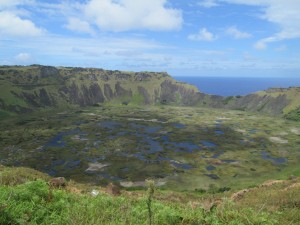
Orongo is located next to a huge crater with water and plants that are only found in the crater. It is quite a sight! The ruins at Orongo are of houses and ceremonial platforms. No moai (the large headed statues Easter Island is famous for) are currently located at Orongo. But don’t worry, we saw plenty of them elsewhere.
Friday we took a short walk to the sites closest to town, Tahai and Ana Kakenga, with five or so moai. Then we went diving. The ocean off of Easter Island is incredibly clear so the reefs and fish looked fantastic on our dive. There was a submerged moai at the dive site, but we found out after the dive that it was a fake. After diving, we had a drink on the water and then we had dinner at a restaurant in town known for its seafood casseroles.
Saturday was our last day on Easter Island and we did a full day tour of the sites around the island. We visited five sites on the tour. The first site had a cave and great ocean views but no moai. The second stop was at Ranu Raraku or the moai quarry. This is where the moai were carved from the rocks and hundreds of them litter the site. We walked up the hill to view different areas of the quarry and it was fascinating to see the moai in various stages of completion lying and standing haphazardly around the site. The moai dated from as early as the 14th century to as late as the 19th century.
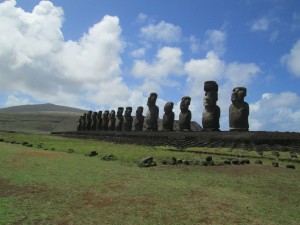
We had lunch at Ranu Raraku and then headed to Tongariki which is a restored site featuring 15 moai on a platform. From Tongariki we went to the last stop for the day, Anakena Beach. Anakena has a few restored moai on a platform but the real draw here is the picture perfect white sand beach (with a pretty hefty current I accidentally discovered). After an hour and a half here, we returned to town.
Sunday we flew back to Santiago. We had a couple days in Santiago to relax in an apartment we rented in Bellavista and to get ready for the next leg of our trip. On Tuesday night we departed South America for the Philippines via a 40 hour, two stop travel marathon.
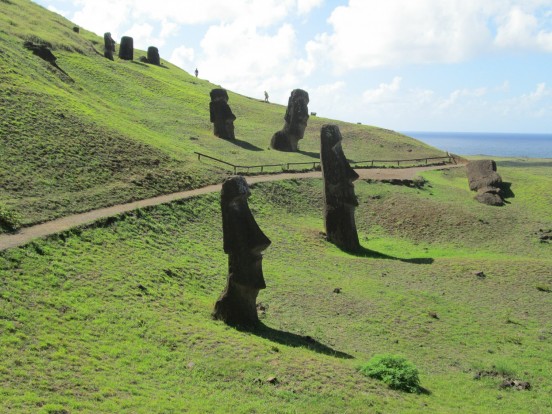


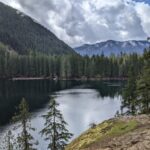
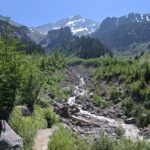
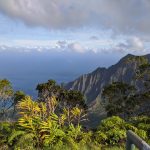
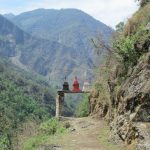

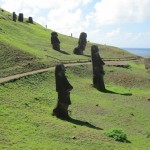
Pearse Edwards
April 5, 2016 — 2:01 pm
What an incredible experience to visit Easter Island. I’ve watched a few short documentaries on the area, but didn’t know about some of the stuff you got to see. I am enjoying your series of posts. Safe and fun travels – Pearse
stacy
April 9, 2016 — 8:30 pm
Thanks Pearse! Hope all is well in NC!
Tamara
April 7, 2016 — 4:47 pm
Easter Island is somewhere I would love to see! I remember when I found out that the maoi heads had bodies. Super cool.
Tamara
May 23, 2016 — 4:15 pm
You win for sending the coolest postcards ever! I just got three from you today. One of today’s postcards was from Rapa Nui. Thank you so much.
stacy
June 10, 2016 — 10:19 am
Yay! I have more for you but having trouble posting. You may get a stack of non postmarked ones when I return but I will keep trying…